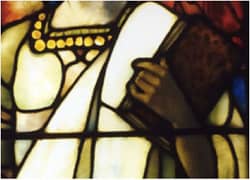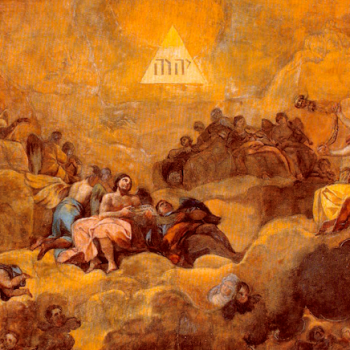 Now Featured in the Patheos Book Club
Now Featured in the Patheos Book Club
Tiffany's Swedenborgian Angels:
Stained Glass Windows Representing the Seven Churches from the Book of Revelation
By Mary Lou Bertucci and Joanna Hill; Foreword by Reverend Susannah Currie
The eighteenth-century religious movement founded by admirers of the writings of the scientist turned theologian, Emanuel Swedenborg (1688-1772) set in motion the eventual creation of these extraordinary windows. Born in Stockholm to stanch Lutheran parents, Swedenborg devoted the first half of his life to scientific endeavors, but at the age of fifty-six began having mystical experiences that informed the final twenty-seven years of his life. Always signing his work "Servant of the Lord," Swedenborg believed that Jesus revealed to him a way to reform Christianity (which Swedenborg considered distorted through the centuries) and directed him to record his visions and experiences: the nature of heaven and hell, his conversations with angels and demons, and humanity's divine transformation from materialistic to spiritual beings.
Of his discussions with heavenly beings, he writes in The Apocalypse Revealed (1766) of an inner meaning in the Book of Revelation in which the seven churches represent different stages of spiritual growth--both in individuals and churches--as well as their ability to be receptive to a new Christianity that Swedenborg called the New Church. He also believed that the seven angels represent entire communities of celestial beings who are connected with people on earth and, in turn, each person's stage of spiritual development.
Of the numerous principles on which Swedenborg based his doctrine, one is that evil is a man made concern and that "everything in the natural world finds its cause in something true that is spiritual and its fundamental in something good that is heavenly." Emanuel Swedenborg never tried to establish a religious organization during his lifetime; however the New Church movement, conceived from his philosophical and theological writings, was founded in England fifteen years after his death. Missionaries brought Swedenborg's system of beliefs to the United States and, in 1817, the Swedenborgian Church of North America was formed. It was Swedenborg's writing on the natural world that would inspire the spiritual journeys of several prominent eighteenth-century Americans such as Ralph Waldo Emerson, Walt Whitman, and American landscape painter, George Inness.
Tiffany's window series ‘Angels Representing Seven Churches' was inspired by the descriptions in Chapters 2 and 3 of the Book of Revelation. These letters to the angels of the churches in the last book of the Bible, as recorded by the Apostle John, are the last touchstone on earthly concerns before the book takes a turn to otherworldly imagery. The Swedenborgian Church, which commissioned the windows, has in its theology that the letters to the seven angels of the churches can be read as the seven possible states that human beings can reach in their journey of spiritual development, or on another level as seven stages of development that all individuals have access to in their spiritual journey.
The letters to the churches, and to the associated angels to whom John is directed to write, are excerpted in the inscriptions at the bottom of each window. The weaknesses of each community, with warnings of the consequences of their actions, are addressed and promises for reform are highlighted. The gifts that will be received when these weaknesses are overcome are depicted in the hands of each angel. In the address of each letter to the ‘angel of the church' the scripture passages convey the idea that angels correspond to communities, types of people, and spiritual states.
11/16/2011 5:00:00 AM




